Here is one of the most common methods to make seitan at home, using the ‘wash the flour’ method.
Essentially, the flour is kneaded with water to form a dough, just like making bread minus the sugar, salt, and oil. Next, wash the dough gently with water several times until most of the starch is removed from the dough, leaving mainly the wheat protein behind.
This protein mass is called seitan, used by every Chinese vegetarian as a meat substitute to prepare various mock meat dishes.
This article explains how to make seitan (also called wheat meat or vegan meat) with this method. In addition, there are separate recipes on this food blog describing how to use them to make various vegetarian dishes.
Note: This post may contain affiliate links. Please read my privacy policy for more info. I may receive commissions for purchases made through links in this post. As an Amazon Associate, I earn from qualifying purchases.
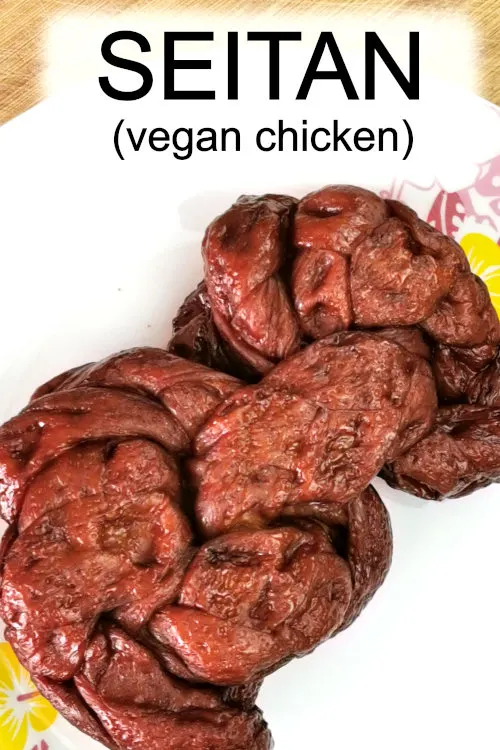
1. Knead the dough
The first step is to make a dough, pretty much like making bread except without yeast.
- Measure the amount of flour you need in a large mixing bowl.
- Add water to the flour and knead it until it forms a nonsticky dough. It is pretty sticky initially, but it will become smooth and nonsticky after kneading it.
- When the dough is no longer sticky, place it on a work surface and stretch it thinly. After that, roll the dough up, turn it to ninety degrees, and repeat the stretching process.
- Continue kneading and stretching the dough for ten minutes until the surface becomes shiny. This step is crucial to forming the gluten, which develops the meat-like texture of seitan.
- Place the dough in a large pot and fill with water just enough to submerge the dough. Keep it aside for one to two hours until the gluten fully relaxes before washing the starch away in the next step.
Note:
- The type of flour to be used should be bread flour or all-purpose flour with relatively higher protein content. Pastry flour has too little protein, which will yield a small amount of seitan.
- The amount of water I use for making the dough is 2/3 of the flour by weight. So, for example, you need 666ml of water for 1kg of flour. It does not need to be exact.
- You can use a food processor or stand mixer with a dough hook to replace the manual kneading if you work on a large quantity.
- Turning the dough ninety degrees after each round of kneading helps stretch the gluten in all directions.
- You can soak the dough in the water for up to eight hours or overnight. However, it tends to fall apart if you soak it for too long.
2. Wash away the starch
After soaking for more than one hour, the seitan dough should have relaxed.
- Gently squeeze the dough with your fingers to release the starch into the water. It is now soft and must be done gently to prevent falling apart. The water will quickly become milky.
- Continue washing the dough for about three minutes, and then store the starchy water in another container.
- Add some fresh water to wash the dough for the second time. You will notice the texture of the dough will start to become more stretchy and smaller due to removing the starch.
- Continue washing until the water becomes milky again. Then repeat the process for the third time. At this point, you may want to pour the dough through a colander to remove the starchy water, as it will be too soft to handle by hand.
- Repeat the washing process another four times or more, or until the water no longer looks milky but slightly murky, like the water we used to wash the rice before cooking. You will notice the dough will slowly turn into a stretchy mass.
- When the dough has shrunk considerably, turning from white to beige and becoming more stretchy, it is time to stop further washing. Remove the seitan from the container.
- Let it rest for fifteen minutes before continuing into the next step.
Note
- I will keep the starch water from the first, second, and third wash for other recipes.
- After two to three washes, the dough will start falling apart, which is expected. Then, it will become more elastic and come together again.
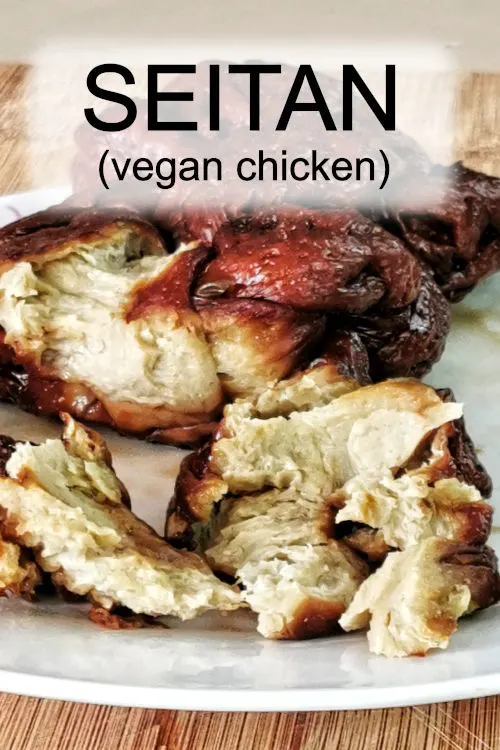
3. Braid the seitan
The seitan is now ready for cooking. However, this recipe is intended to create a meat-like texture. Therefore, there is an additional step to make it happen.
Here is how to do it.
- Place the seitan on a work surface, then use your hand to stretch it slowly in one direction until it is elongated like a rod.
- Next, shape it so that it is straight on both sides.
- Cut the seitan lengthwise with a sharp knife into three parts, with one end attached.
- Start to stretch and braid the gluten like making braided bread. Gently pull and stretch it to elongate the gluten while braiding it. Finally, tuck the end into the dough to close it up.
- After that, make a few knots to tighten the gluten further and prevent it from expanding too much while simmering in the next step.
4. Prepare a braising liquid
You can cook the seitan in plain water or vegetable broth, but it is more flavorful if simmered in a braising liquid. Therefore, I use the braising liquid from the soy sauce chicken recipe to enhance the flavor of the seitan.
- Place the seasoning ingredients for braising in a pot as listed in the recipe below.
- Place the seitan in braising liquid and simmer for about an hour. Turn over the seitan occasionally. It takes an hour to infuse the flavor into the interior of the seitan.
- Transfer the seitan and the braising liquid to a ziplock bag or sealed container and refrigerate overnight to let the seitan absorb more flavor. On the next day, I will then be able to use it to prepare my favorite vegetarian dish. This seitan taste and looks like soy sauce chicken!
You can cut or shred the seitan and use it for cooking, just like chicken breast meat. Some of my favorite ways are stir-frying it with vegetables, making braised tofu with mock chicken meat, and shredding it into small pieces for fried rice and noodles.
The starch water collected is the ingredient to make Liangpi, cold noodles from Shanxi, served with a spicy sauce, cucumber, and bean sprouts.
Here is the link to the Liangpi recipe.
Alternative method
If you do not want to make seitan from scratch, you can opt to start with Vital wheat gluten flour. It should be available in the grocery store near you or purchased online. The process of making does not involve washing away the starch and takes less time. All you need is to add water to the Vital gluten flour plus some chickpea flour and knead it, which bypasses the washing steps.
You can incorporate some dry ingredients into the dough for extra flavor in the basic seitan recipe while kneading if you take this route. Common seasoning ingredients are garlic powder, onion powder, liquid smoke, olive oil, black pepper, or even a small portion of vegetarian bouillon cubes.
Is seitan gluten-free?
Gluten is not gluten-free, which is not for you. If you have celiac disease or irritable bowel syndrome, please use meat alternatives prepared with beancurd skin. Here is the vegetarian duck recipe prepared with beancurd skin.
Other recipes
Check out how to use the seitan to make a simples vegan stir-fry: Vegan chicken stir-fry with vegetables and mushrooms.
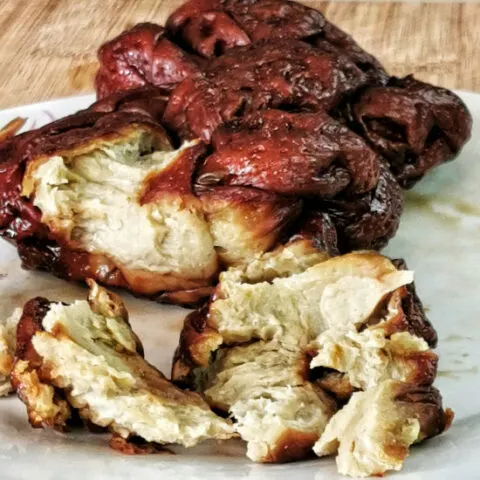
Seitan- How to make it at home from scratch
Here is one of the most common methods to make seitan at home, using the ‘wash the flour’ method.
Essentially, the flour is kneaded with water to form a dough, just like making bread minus the sugar, salt, and oil. Next, wash the dough gently with water several times until most of the starch is removed from the dough, leaving mainly the wheat protein behind.
Instructions
Knead the dough
- Mix the water with the flour and knead it until it forms a nonsticky dough.
- Knead the dough for ten minutes until the surface becomes shiny, and gluten is formed.
- Submerge the dough in water for two hours.
Wash away the starch
- Wash the dough for three minutes to release the starch into the water. When the water becomes milky, pour it away and use fresh water to rewash it.
- Repeat the washing process a few times until the water becomes semi-translucent.
- Let the washed dough rest for fifteen minutes.
Braid the seitan
- Place the seitan on a work surface, then stretch it until it is elongated like a rod.
- Cut the seitan lengthwise with a sharp knife into three parts, with one end attached.
- Start to stretch and braid the gluten like making braided bread. Finally, tuck the end into the dough to close it up.
- After that, make a few knots to tighten the gluten further.
Braise the seitan
- Bring ingredients B to a boil.
- Place the seitan in braising liquid and simmer for about an hour. Add more water if necessary.
- Transfer the seitan and the braising liquid to a ziplock bag or sealed container and refrigerate overnight.
Recommended Products
As an Amazon Associate and member of other affiliate programs, I earn from qualifying purchases.
Nutrition Information:
Yield: 1 Serving Size: 1Amount Per Serving: Calories: 3853Total Fat: 12gSaturated Fat: 2gTrans Fat: 0gUnsaturated Fat: 6gCholesterol: 0mgSodium: 8617mgCarbohydrates: 803gFiber: 32gSugar: 29gProtein: 115g
This data was provided and calculated by Nutritionix on 11/5/2022

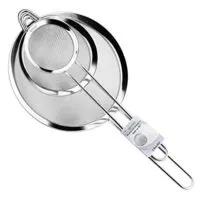

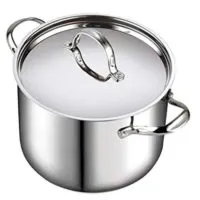

Kay
Thursday 4th of May 2023
Hello, Could you tell us for what other recipes you use the water? Thank you for this very detailed and informative article. I bought seitan last night and I was wondering if it could be home-made. I might try your recipe during the summer holidays.
KP Kwan
Friday 5th of May 2023
I only use it to make liangpi. Here is the link: https://tasteasianfood.com/liangpi/
Leah Burton
Thursday 29th of December 2022
Thank you for your time & knowledge in writing this article. The amount of effort to produce the Seitan gives me a new appreciation for the people that make it.
Nina
Sunday 27th of November 2022
Thank you , will try it, looks delicious.. Hope you will have more Seitan recipes...
KP Kwan
Wednesday 11th of May 2022
Hi, this is KP Kwan. I am happy to see you in this comment area, as you have read through my recipe. I am glad to reply to any questions and comments as soon as possible.